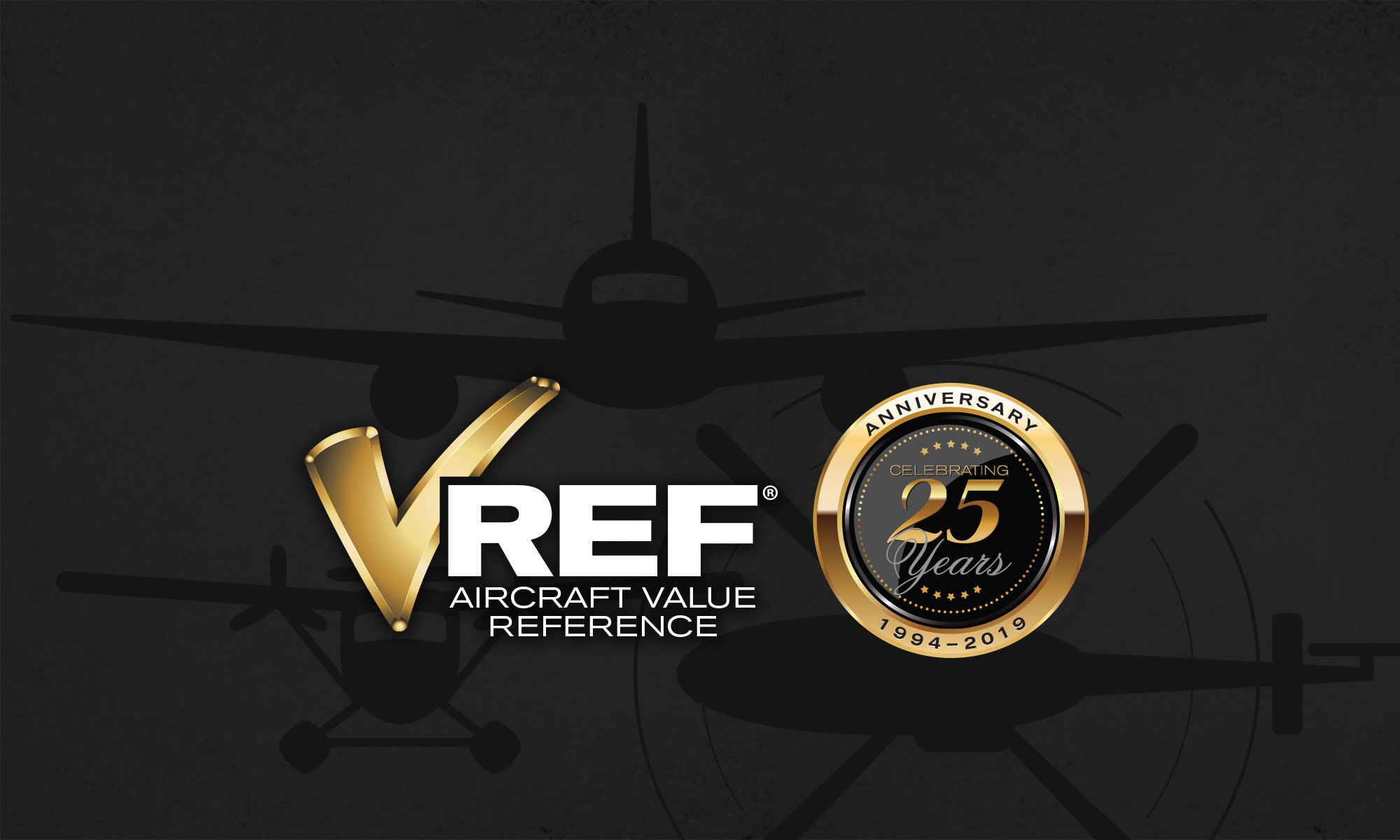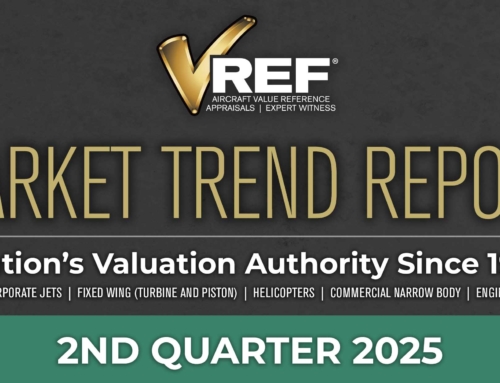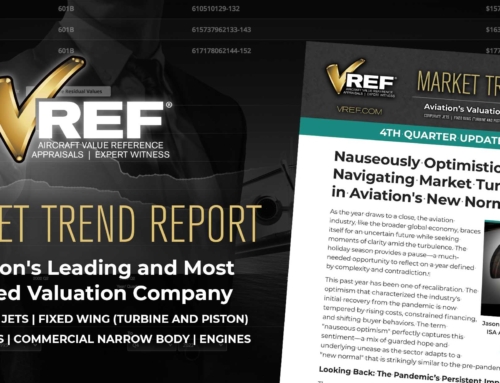We hope everyone had a Happy Holiday Season and enjoyed some time off with friends and family. 2018 was a welcomed change to the market environment from years past, we witnessed inventory levels drop to 10-year lows, as well as a significant uptick in new aircraft orders. Business aircraft finally welcomed the long overdue positive correction into a seller’s market. For the manufacturers of business aircraft, there were just over 200 new orders,but the shining star was Textron Aviation who closed the fourth quarter with a 12 percent increase in revenue from 2017 numbers. We believe this trend will continue throughout 2019, and even with continued stock market jitters, and geo-political issues at an all-time high, buyers are still shaking it off.Inventory is going to continue to shrink and 2020 compliance will be the nail in the proverbial coffin for a number of aging aircraft.
This year is an important year for VREF, it marks our 25thAnniversary and in case you weren’t aware our software is being redeveloped and we will be releasing updates via our website vref.com. We will be releasing an update to our engine values and updating our Residual Value forecasts. As we get closer to live beta testing, we will be making contact with a number of clients to assist. If this is of interest to you, or if you have ideas we need to hear about please feel free to email our President Jason Zilberbrand HERE.
We have been improving our products and as part of that process and we are very excited to announce that AIC Title Service is partnering with us on our VREF Verified Reports. Now every report will feature a Title Search which includes; ownership status, lien status, major alternations and Form 337’s along with ownership or chain of title and a lien search. You will also find our reports available from AOPA, air.oneand primaryflightcontrol.com and as we add more marketplaces we will keep you updated.
In equally exciting news, VREF has been growing its team and we are very proud to announce Richard Hart and Jeremy Cox have joined our appraisal team. We now have two of the industry’s top appraisers and aviation experts ready, willing and able to help you value your assets. Richard brings over 40 years of hands on Helicopter experience to VREF and he is considered one of the industry’s experts. We are fortunate to have him, and we hope you will welcome him to the team. Richard is based in L.A and you can find him at Van Nuys airport most days so if you are in the neighborhood stop by and introduce yourself. Likewise, Jeremy Cox is no stranger to aviation, as he has over 40 years of experience as well. Jeremy brings his diverse business jet, warbird and commercial aircraft experience to VREF along with his exceptional knowledge base. Jeremy is based out of St. Louis and he attends the vast majority of conferences and he will be speaking at NAFA this year. Please join us in welcoming them to the team and if you need an appraisal you know where to find help.
In an effort to increase communication especially with safety of flight issues we are taking advantage of social media platforms and have found several Facebook groups to be worth looking into if you want to stay on top of all thing’s aviation. These are the groups we like, so feel free to check them out:
- Aviation Buy, Sell, and Trade
- Private Jet Pilots
- Aircraft Sale and Trade
VREF also posts to these groups and our own social media outlets on a daily basis. You might have seen Ken Dufour’s or Jeremy Cox’s write up on the Proposed AD for all Piper PA-28 Series aircraft and the PA-32 (AD 2018-CE-049-AD), in case you missed it you can read about it HERE.
We are now well into 2019 and guess what? 2020 compliance is not getting delayed. You must have ADS-B Out to fly in controlled airspace. ADS-B improves safety and efficiency in the air and on runways, reduces costs, and lessens harmful effects on the environment.
ADS-B Out will be required in the following air space:
- Class A, B, and Cairspace
- Class E air space areas at or above 10,000 ft MSL over the 48 states and DC, excluding airspace at and below 2,500 ftAGL
- Airspace within 30 nautical miles (nm) at certain busy airports from the surface up to 10,000 feet MSL; airports listed in appendix D to part
- Above the ceiling and within the lateral boundaries of a Class B or Class C airspace area up to 10,000 feetMSL
- Class E air space over the Gulf of Mexico at and above 3,000 feet MSL within 12 nm of the coastline of the UnitedStates
Any airspace that requires the use of a Transponder in the USA today will on January 01, 2020 also require aircraft to be equipped with a Version 2 ADS-B Out system.
Before we jump into the market updates, I wanted to let you know that we are continuously improving the database. We have added in a ton of new data in recent months, and the AD’s and SB’s are being updated regularly as well as all 2019 model and equipment updates. We have also added a couple new aircraft to the database. The P-51 Mustangs have been inserted and this was no easy task. So, take a peek and let us know your thoughts. We also added Van’s RV12iS, Sling Aero LSA 2, The Cirrus SF50 G2, Embraer Praetor’s, Honda Jet Elite, Viking DHC6-400, completed optional equipment and package pricing for Pilatus PC12NG and PC24 and we have updated a number of the commercial aircraft including all the Boeing’s. We have also added literately hundreds of options for the helicopters and have been adding missing avionics equipment across all categories.
Without any further ado, this is a recap of 2018 4thQ and a Projection for Q1 2019 by market segment.
Light Sport: The Light Sport Markethas been led by the trainers and an onslaught of choices ranging from the old standbys to those built for the next generation of pilots. The top performing aircraft for 2018 were the Zenair CH-750 STOL and Icon A5 with 57 deliveries each, and it’s also one super cool aircraft. Van’s was just behind with 41 deliveries of the RV-12.
Piston Singles: Coming off the best quarter in recent history and showing no signs of slowing. Most new OEM’s are sold out through 2021 and we expect this to continue. Trainers are as hot as ever, in fact, good luck finding one. All models are up across the board and this increased value will continue through 2019. The Flight Training market demand is causing high demand on traditional single engine aircraft utilized for training, i.e. Cessna 152/172, Piper Warriors, Archers and Arrows, as well as Diamond Aircraft, Tecnam and other newer manufacturers are assisting in filling the void. Low time, un-damaged aircraft are always difficult to purchase.
Piston Twins: The Flight Training market demand is affecting this market segment as well. There is high demand for piston twin training aircraft, aircraft like the Piper Seminole and Diamond Twin Star are hard to come by.
The piston twin market is much more thinly traded than that of the single-engine turboprop, and additionally it is an aging fleet. That means a piston multi-engine aircraft is more difficult to sell. That said, the smallest of the multi-engine aircraft, such as the Piper Seminole, have been gobbled up by flight schools and are hard to find. Flight schools, not businesses, are the primary market now for light piston twins.
Beechcraft Baron Owners still love their aircraft, and the Piper Seneca is still in production, but single-engine turboprops are produced in much larger numbers.
Those are the reasons why some pilots who once considered a piston multi-engine aircraft are taking a long look at the single-engine turboprop market.
Turbo Props: Thirty years ago, there weren’t many single-engine turboprop aircraft on the market. Many pilots made the decision to buy an aircraft with two engines to keep the family safer—especially when making long flights above water—and to go a little faster than their former piston single-engine aircraft. Today the story is much different.
Today there is cannibalization of the piston multi-engine market by single-engine turboprops. The aircraft responsible for this include the Piper Meridian, now known as the Piper M500 and M600, the Daher TBM, and the Pilatus PC-12 NG. Today there is not only an ever-growing choice of single-engine turboprop aircraft to choose from, but they are priced close to the cost of a multi-engine aircraft yet have similar capabilities.
The reliability of a turboprop is far better than the risk of an engine failure on a multi-engine aircraft. People have voted with their feet, moving towards dealers of turboprop single-engine aircraft, even though those aircraft cost a little more and have a higher operating cost.
Today’s aircraft buyers feel one engine is easier to manage and the aircraft systems are less complex.
2018 was an equally great year for the Turbo Prop market. The models in high demand last year continue to be hot commodities in 2019. PC12’s are scarce on the pre-owned market and along with King Air B200 and 350’s. 49% of new deliveries last year were made by King Air and Pilatus a trend that will continue. It seems that there are more and more aircraft models competing in this space, and simply stated this is a fantastic category of aircraft that meets a very large buying segment. When you factor in specialty aircraft like the Viking and Kodiak its apparent manufacturers are building what they see as a huge opportunity to offer niche aircraft in a growing segment of enthusiast aviators.
Business Jets: We anticipate 2019 to play out much like 2018 did. A seller’s market with a lack of like-new used inventory should produce a higher value. Many buyers are reporting settling for a 3rdor 4thchoice as inventory continues to sell. There were 200 new sales made by the OEM’s in 2018 which will result in about the same new deliveries for 2019. We expect Bombardier and Gulfstream to benefit in the long-range cabin class market as the 7500 and G500 are delivering, as a side note we anticipate the older GEX’s and G550’s to continue softening as buyers look for the latest and greatest technology available. There were over 700 used transactions both on, and off market and the top three models that had the most transactions last quarter were the CJ2/CJ2+, Hawker 800XP and the Citation Mustang.
Commercial Aircraft: Boeing and Airbus set records in 2018, with 800 and 806 deliveries respectively for each OEM. Boeing logged 893 new orders in 2018 compared to 747 for Airbus.
Helicopter: Kurt Robinson reports that he expects less sales of new Robinsons in 2019 with production remaining to hold steady at an annual rate of approximately 300 (the average over the last 5 years) helicopters across all models with a possible increase to 309 in 2019. He mentioned that the combination of a stronger dollar, higher interest rates and potential tariffs on China and Russia will adversely affect their sales to foreign countries as exports represent around 70% of their total sales.
Airbus delivered 356 rotorcraft in 2018 and as of the end of 2018 has 717 helicopters in their backlog of orders (of all models). Some good news about the Super Puma regarding Airbus’s success in finding customers for a re-purposed H225 in the Military market as well as executive, EMS and law enforcement government agencies.
Bell has delivered its 100th Model 505 helicopter and expects continued strong sales, they mention that they expect some gradual market recovery in 2019 across all model lines. They announced a new EPX version of the 412 and are continuing flight testing on the 525 Relentless.
Sikorsky has seen a few of the S-92 aircraft currently idle being placed back into service, however with a large number of them available, sales of new S-92’s is likely to remain poor. The S76 sales are also currently flat with the expectation that this status will remain thru 2019. Sikorsky does have better hopes with their military aircraft including the SB-1 Defiant FVL (future vertical lift) prototype.
Leonardo is having great success with the AW139 with almost 1,100 sold to more that 270 customers worldwide. The AW139 has been able to find success in supporting government operations, EMS, SAR, patrol and security roles proving to be a very versatile and adaptable aircraft.
Overall, as described by Frank Wolfe at Rotor & Wing, most manufacturers are optimistic about 2019 and do expect some growth in both the civilian and military helicopter markets with global HEMS (helicopter emergency medical service) aircraft leading the way.
DRONE/UAV: On December 20th the FAA quietly announced the release of a Request for Information (RFI) looking for partners to help develop a realistic approach to sharing data that would be required to remotely identify small drones in controlled airspace. The data collected would include a unique identifier for the UAV, tracking information as well as drone owner and remote pilot identification. This initiative by the FAA is an important step toward forming the technical foundation that will enable the full integration of manned and unmanned aircraft in controlled airspace. Many companies will be applying to be part of it, and it will have a major impact on how and when Remote ID will become a reality.
In another major step forward theNational Waiver for Drone Operations Over People and BVLOS granted State Farm Insurance the first national waiver by the FAA and it’s a big deal. The national waiver allows State Farm to conduct drone operations over people (OOP) and flights beyond the pilot’s visual line of sight (BVLOS), both of which have been cited as the next big opportunity for commercial drone operators. The company was the first insurer to receive FAA approval to operate drones for commercial use (2015) and was also the first and only insurance company to be granted an FAA waiver for BVLOS and operations over people for catastrophe damage assessment (2018). Along the way, they’ve deployed claims drone pilots for real-world roof inspections and became the only insurance company selected for the FAA’s Integration Pilot Program (IPP). These milestones demonstrate their high level understanding of the benefits drones create for everyone from individual Claims associates to the organization as a whole. The FAA’s limitations around conducting drone operations over people and BVLOS have been questioned by many, but the FAA has literally asked operators to bring them their safety cases. State Farm did that through a series of tests and waiver approvals that provided the FAA with the info they wanted and needed. Doing so has put State Farm in the position to be able to utilize enhanced tools to better serve their customers while also helping move the whole UAS industry forward in terms of both safe drone operations and FAA process.





